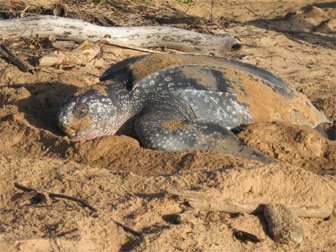|
|
A new study in Marine Pollution Bulletin has confirmed that the world’s largest sea turtle is succumbing in startling numbers to an environmental issue that receives little attention: plastic trash in the oceans.
To conduct his study Dr. Mike James from Dalhousie University and colleagues looked back over four decades of leatherback necropsies, i.e. post-mortems of animals.
“We wanted to see if plastics ingestion in leatherbacks was hype or reality,” says James. It has long been theorized that leatherbacks often confuse plastic trash, especially plastic bags, with one of their favorite prey—jellyfish. In an unfortunate connection, both jellyfish and plastic trash are often found at where oceanic water masses meet.
 Female leatherback sea turtle making nest in Suriname. Photo by: Tiffany Roufs. |
“After reviewing the results of 371 necropsies since 1968, we discovered over one third of the turtles had ingested plastic,” James says.
Plastic consumed by turtles leads to partial or complete obstruction of gastrointestinal tract. While the plastic takes its toll on the turtle’s diet, energy, and reproduction, a complete blockage can lead to starvation. The more plastic a turtle ingests the more likely the trash will kill it, but even a little plastic can weaken a turtle significantly.
“The frustrating, yet hopeful aspect is that humans can easily begin addressing the solution, without major lifestyle changes,” says Dr. James. “It’s as simple as reducing packaging and moving towards alternative, biodegradable materials and recycling.”
Leatherbacks are currently classified by the IUCN Redlist as critically endangered. Having inhabited the earth for over a hundred million years—surviving comets, global warming, and ice ages—it would be sadly ironic if the leatherback should go extinct due to something humans consider as innocuous as plastic bags.
Related articles
Saving leatherback turtles in South America’s smallest country, Suriname: An interview with Liz McHuron
(01/27/2009)
After a year studying marine biology at Moss Landing Marine Labs, Liz McHuron headed off to the little-known nation of Suriname to monitor leatherback sea turtles. Her responsibilities included implementing a conservation strategy for a particular beach, moving leatherback nests in danger of flooding, and educating volunteer workers on the biology, behavior, and conservation efforts of the world’s largest, and most unique, marine turtle. I visited McHuron during her time at the beach of Galibi in Suriname; she proved to be the sort of scientist who refused to be deterred: breathtaking humidity or downpours, fer-de-lances on the beach or jaguars, Liz was always on the move, always working to aid the critically-endangered leatherbacks while studying them with the thoroughness inherit in a born scientist.
Discovery of new leatherback migration route may help save species
(07/15/2008)
Scientists have discovered a new migration route for the world’s largest turtle, the leatherback. The route takes the 2,000-pound marine turtle from the Playa Grande beaches in Costa Rica to an area deep in the South Pacific.
Volunteering with Leatherback Sea Turtles in Galibi, Suriname
(07/08/2008)
The northern coast of Suriname is one of the best places in the world to view the largest turtle, the marine Leatherback. Watching the turtle rise out of the tides onto the beach gives one the sense of meeting something ancient, rare, and more sea-monster than marine turtle. Yet, if I call it a sea-monster, I do not mean that it is frightening or ugly: far from it. But it is mysterious, terrible, and wondrous.
Sea turtle makes record migration – 12,774 miles
(02/07/2008)
Satellite-tagging has revealed that a leatherback sea turtle (Dermochelys coriacea) swam a total distance of 20,558 kilometers (12,774 miles) over 647 days from Jamursba-Medi, Indonesia to the coast of Oregon. The results are published in The State of the World’s Sea Turtles magazine, a publication launched by conservation International and the IUCN Marine Turtle Specialist Group.